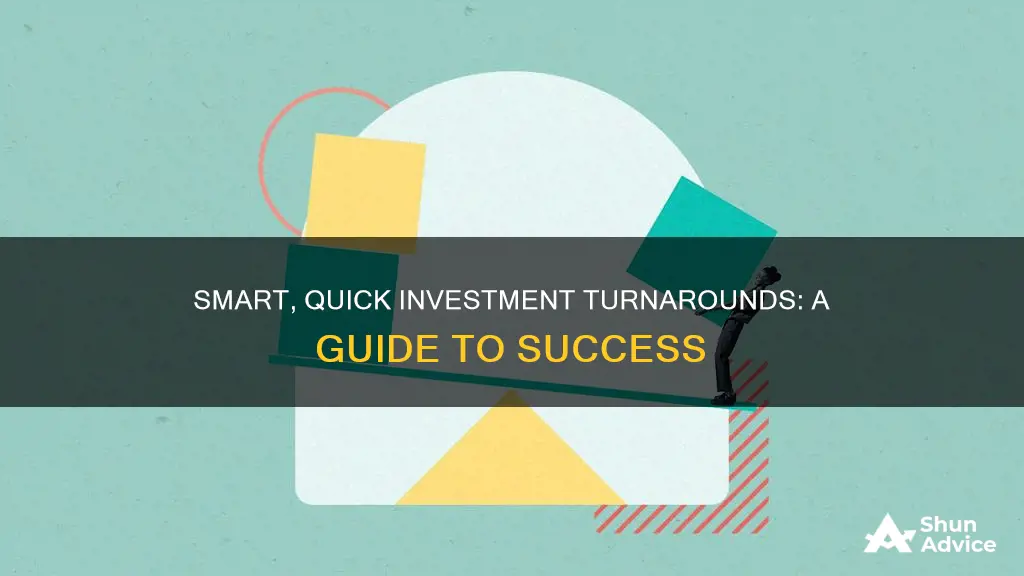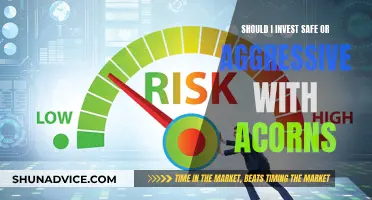
Making the right investments with a quick turnaround requires a high-risk, high-return, and long-term strategy. A popular approach is to invest in companies that are under severe financial stress but with a rebound in sight. This strategy involves buying shares of companies that are restructuring and addressing problems that have caused their decline, and then waiting for them to turn things around. It is important for investors to have a thorough understanding of the company, its business model, and its capability to make a comeback. Other quick turnaround investment strategies include investing in tax liens, buying real estate below market value, investing in income trusts and master limited partnerships, and buying high-yield bonds.
What You'll Learn

Invest in tax liens
Investing in tax liens is an indirect form of real estate investing. When a homeowner fails to pay their property taxes, the local government places a tax lien on the property and issues a tax lien certificate. This certificate details how much the property owner owes in taxes. If the taxes remain unpaid, the certificate can be auctioned off to investors.
Step 1: Understand tax liens
Before investing in tax liens, it is important to understand what they are and how the process works. A tax lien is a legal claim placed on a property by the local government, typically the city or county, when a homeowner fails to pay their property taxes. The government then issues a tax lien certificate, which includes the amount of tax owed, plus any interest or penalties.
Step 2: Check state availability
The sale of tax lien certificates to investors is not available in all states, so be sure to check if it is allowed in your state before proceeding.
Step 3: Research the process
Tax lien investing is distinct from stock market or bond investing. In most cases, investors purchase tax lien certificates at auctions, which can be held in-person or online. Bids are based on either a fixed cash amount or an interest rate. It is important to understand the bidding process and the potential risks involved.
Step 4: Identify properties
Once you have decided to enter a tax lien auction, contact your local tax revenue office to gather information on upcoming auctions and the requirements for participation. Research the properties being auctioned, including their value, condition, payment requirements, and deadlines. It is also crucial to understand the foreclosure process, as you may need to initiate it if the homeowner fails to repay their taxes.
Step 5: Bid on tax lien certificates
At the auction, investors bid on properties based on the tax lien amount or the interest rate. The bidding strategy will depend on the investor's goals and preferences. It is important to consider the potential risks and returns associated with each property.
Step 6: Take control of the tax lien certificate
If you are the winning bidder, you will take ownership of the tax lien certificate. This gives you the right to collect when the homeowner repays their overdue tax bill, plus any interest or penalties. It is important to keep track of deadlines and initiate communication with the homeowner to ensure timely repayment.
Step 7: Prepare for potential outcomes
There are two possible outcomes: the homeowner either repays their overdue taxes or they don't. In the first case, you will receive your initial investment back, plus the interest rate you bid at the auction. In the second case, you may need to start the preforeclosure process and, eventually, take ownership of the property through foreclosure. However, this is a rare outcome, as most homeowners repay their taxes before the foreclosure process begins.
Goldman's Investment Management: Powering Success and Growth
You may want to see also

Buy real estate below market value
Buying real estate below market value is a great way to make a quick turnaround on your investment. Here are some tips on how to do it:
Online Real Estate Auctions
Online auctions are a great way to find below-market investments as you don't have to visit the property in person and many sites give you 30 days to close the deal. This gives you time to sort out your financing and you can buy property anywhere in the country without leaving your home. You can also use these auctions to practice bidding and estimating repairs, which is critical when making a real offer.
Real Estate Websites
Online mega real estate sites like Zillow or Trulia have search filters that allow you to set up email alerts for properties that match your specific parameters, including "For Sale By Owner". "For Sale By Owner" sellers tend to be more flexible and open to creative seller financing than those represented by an agent. By working with a seller directly, you can talk to them about their options and help them get a faster sale and sometimes a higher price by being flexible with the terms of your offer. For example, the seller might decide to hold a first or second mortgage on the property and take monthly payments until they are paid off.
Advertising Websites
Websites that advertise various items for sale, including properties, are great sources for finding lower-priced real estate. By searching for wholesale real estate deals on sites like Craigslist, you might find a real estate wholesaler who can supply you with investment opportunities. Consider using keywords when you begin your search, such as “fixer-upper”, “needs work”, or “investor special”. Facebook, for example, allows you to use free social networking strategies or paid ads to find deals from motivated sellers.
Direct Mail
Direct mail is a tried-and-true method for finding motivated sellers. This strategy is more advanced but if you have a big appetite for deals, direct mail is for you. The best way to find success with direct mail is through multi-step mailings to targeted lists, such as vacant homes, properties behind on taxes, financially distressed, code violations, probate or free-and-clear properties.
Write a Real Estate Love Letter
Writing a letter to the seller can be a powerful tool in getting them to accept a below fair market offer. Focus on making a connection by finding some common ground between you and the seller. Tell the seller how much their home would mean to you and share with them who you are and why you are good people. People tend to do business with people who are similar to them. You can also allude to end-of-the-world scenarios, which can really motivate your seller to offload. Finally, focus on the benefits of a simple life, especially if the seller is older and has experienced their fair share of troubles with homeownership.
Unlocking Private Equity: EVCA Investment Strategies
You may want to see also

Invest in high-yield stocks
High-yield stocks are a great way to make your capital compound with very little risk. They are stocks with stable businesses that pay dividend yields of 5% to 15% or more. Some industries offering such high yields include electric utilities, oil tankers, and real estate investment trusts.
When investing in high-yield stocks, it is important to evaluate the stock by comparing the dividend yields among its peers. If a company's dividend yield is much higher than that of similar companies, it could be a red flag and is worth additional research. Look at the stock's payout ratio, which tells you how much of the company's income is going towards dividends. A payout ratio that is too high means the company is putting a large percentage of its income into paying dividends.
Another thing to keep in mind is that dividends in taxable brokerage accounts cause taxes to be realized in the year the dividends occur. For investors with taxable accounts and in high-income brackets, dividend stocks might not be as tax-efficient as other options.
You can look for stocks that pay dividends on many financial sites, as well as on your online broker's website. You can also check out free stock screeners.
Building an Investment Portfolio: The ETF Way
You may want to see also

Enrol in dividend reinvestment plans
Dividend Reinvestment Plans (DRIPs) are a great way to make the right investments and see quick returns. DRIPs allow investors to automatically reinvest cash from dividend payments, and several companies offer discount DRIPs, meaning you get a bonus of 2-5% each time you reinvest.
DRIPs are a good strategy for those who are not dependent on their dividend income and are looking to cultivate their savings. They are also a good option for those who want to bypass brokerage fees, as they allow you to use dividends to purchase shares directly.
With a DRIP, you can automatically reinvest dividends to purchase additional shares of a security. Your cash dividends and capital gains distributions are reinvested into your account automatically, helping you accumulate more shares of the same stock, at no extra charge. DRIPs can save investors time and reduce complicated decision-making, allowing you to "set it and forget it".
For example, imagine an investor owns 100 shares of a company that is currently trading at $100 per share. This company pays out an annual 4% dividend. If the investor has enrolled in a DRIP, they will automatically buy an additional share of stock during the first quarter, increasing their shares to 101, with a balance of $10,100. If the company continues to have a 4% dividend yield, after a year, this investor would own more than 104 shares, worth $10,400. During the next year, this investor is receiving dividends on 104 shares instead of just 100.
Over time, these differences can add up. Assuming the stock's price is the same over 20 years and has a steady dividend yield of 4%, an investor who simply kept the cash from dividends would have $18,000. But for the investor who reinvested dividends, their initial investment would be worth more than $22,000—a 50% higher rate of return.
To enrol in a DRIP, you will need to select your eligible security and then enrol in the plan.
First Eagle Investment Management: Is It Worthy?
You may want to see also

Buy high-yielding bonds
High-yield bonds are issued by entities with low credit ratings from bond rating agencies such as Moody's, Standard & Poor's and Fitch. These bonds are also referred to as junk bonds because of their lower credit quality, which means there is a higher risk of default.
High-yield bonds are a good option if you are looking for a quick turnaround on your investment as they offer a way to earn higher returns in a shorter period of time. The yields for these non-investment-grade bonds are higher than government bonds, meaning investors can earn more income relative to the price they paid for the bonds.
- High-yield bonds are rated below Baa3 by Moody's or below BBB- by S&P and Fitch. The lower credit ratings are based on the issuer's ability to pay interest and repay principal, making these bonds a speculative investment.
- The risk of default on principal, interest, or both, is greater for high-yield bonds than for investment-grade bonds.
- High-yield bonds are subject to credit risk, which increases as the creditworthiness of the issuer falls. It is important to monitor changes in credit quality and conduct due diligence before investing.
- High-yield issuers typically have riskier business strategies and more leveraged balance sheets, exposing them to greater risk of default during a downturn in business conditions.
- High-yield bonds are more likely to have call provisions, which means they can be redeemed or paid off at the issuer's discretion before maturity, potentially leaving investors with capital losses.
- High-yield bonds may have higher transaction costs due to larger spreads between bid and offer prices, and higher costs associated with less liquid securities.
- The market for high-yield bonds is generally less liquid than the market for investment-grade or government bonds, and they can become very difficult to sell when volatility increases.
- Vanguard High-Yield Corporate Fund (VWEHX)
- IShares iBoxx $ High Yield Corporate Bond ETF (HYG)
- JPMorgan BetaBuilders USD High Yield Corporate Bond ETF (BBHY)
- SPDR Portfolio High Yield Bond ETF (SPHY)
- VanEck High Yield Muni ETF (HYD)
Equities 101: Beginner's Guide to Investing in the Stock Market
You may want to see also







